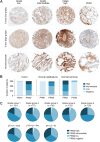Pyruvate Kinase M1 Suppresses Development and Progression of Prostate Adenocarcinoma
- PMID: 35584006
- PMCID: PMC9256808
- DOI: 10.1158/0008-5472.CAN-21-2352
Pyruvate Kinase M1 Suppresses Development and Progression of Prostate Adenocarcinoma
Abstract
Differential expression of PKM1 and PKM2 impacts prostate tumorigenesis and suggests a potential therapeutic vulnerability in prostate cancer.
©2022 The Authors; Published by the American Association for Cancer Research.
Figures

![Figure 1. Increased glucose uptake and a change in PKM isoform expression accompanies Pten loss in mouse prostate tissue. A, Relative [18F]fluoro-2-deoxyglucose (FDG) uptake into the anterior prostate and gastrocnemius muscle of 7- to 11-week-old wild-type (WT) mice and mice with prostate-specific Pten deletion (Ptenpc–/–). Mean ± SD is shown (n = 6). The difference in FDG uptake between genotypes is significant in prostate (*, P < 0.05 by Student t test), but not in muscle. B, Representative H&E and IHC assessment of PKM1 and PKM2 expression in anterior prostate tissue harvested from WT mice of the indicated age. Adjacent seminal vesicle tissue is marked with *. Scale bar = 200 μm. C, Representative H&E and IHC assessment of PKM1 and PKM2 expression in prostate tissue harvested from Ptenpc–/– mice of the indicated age. Scale bar = 200 μm. D, Quantitation of PKM1 and PKM2 expression in prostate tissue harvested from Ptenpc–/– mice of the indicated age as determined by IHC. Tissue from 3 to 6 mice per age group was quantified. E, Representative IHC staining of PKM1 or PKM2 (brown), and PCNA (pink), in tumors from Ptenpc–/– mice of the indicated age. Scale bar = 200 μm.](https://cdn.ncbi.nlm.nih.gov/pmc/blobs/b874/9381135/a70a0a4a524b/2403fig1.gif)



![Figure 5. Pkm2 deletion suppresses increased glucose uptake, affects metabolite levels, and prolongs DNA replication stress and cellular senescence in Pten-null prostate tissue. A, Maximum relative [18F]fluoro-2-deoxyglucose signal (SUV Max) in prostate tissue as assessed by PET of 6-month-old wild-type (WT), Ptenpc–/–, Pkm1;Ptenpc–/–, and Pkm2;Ptenpc–/– mice. Prostate signal normalized to the intensity of the emission spectra in the heart of the same mouse is shown (WT, n = 3; Ptenpc–/–, n = 3; Pkm1;Ptenpc–/–, n = 3; Pkm2;Ptenpc–/–, n = 4). The indicated differences in FDG uptake are significant (*, P < 0.05 by Student t test). B, Principle component analysis of 111 polar metabolites measured by LC/MS in prostate tissue harvested from 6-month-old WT, Ptenpc–/–, Pkm1;Ptenpc–/–, and Pkm2;Ptenpc–/– mice (WT, n = 8; Ptenpc–/–, n = 10; Pkm1;Ptenpc–/–, n = 6; Pkm2;Ptenpc–/–, n = 6). C, Relative levels of all metabolites measured by LC/MS that were significantly different (P < 0.05 by Student t test) in a comparison of prostate tissue harvested from 6-month-old Pten–/– or Pkm2;Pten–/– mice (Ptenpc–/–, n = 10; Pkm2;Ptenpc–/–, n = 6). D, Representative IHC staining for phospho-Chk1 in prostate tissue harvested from Ptenpc–/–, Pkm1;Ptenpc–/–, and Pkm2;Ptenpc–/– mice of the indicated age. Scale bar = 200 μm. E, Quantitation of phospho-Chk1 staining in prostate tissue harvested from Ptenpc–/–, Pkm1;Ptenpc–/–, and Pkm2;Ptenpc–/– mice of the indicated age as determined by IHC. Tissue from 3 to 6 mice per age group was quantified. F, Representative SA-β-gal staining of anterior prostate tissue harvested from 6-month-old WT, Ptenpc–/–, Pkm1;Ptenpc–/–, and Pkm2;Ptenpc–/– mice. The area indicated by the dashed box is shown larger in the lower left inset for the right two panels. Scale bar = 500 μm.](https://cdn.ncbi.nlm.nih.gov/pmc/blobs/b874/9381135/37d6f7cec222/2403fig5.gif)


References
Publication types
MeSH terms
Substances
Grants and funding
LinkOut - more resources
Full Text Sources
Medical
Molecular Biology Databases
Research Materials
Miscellaneous

